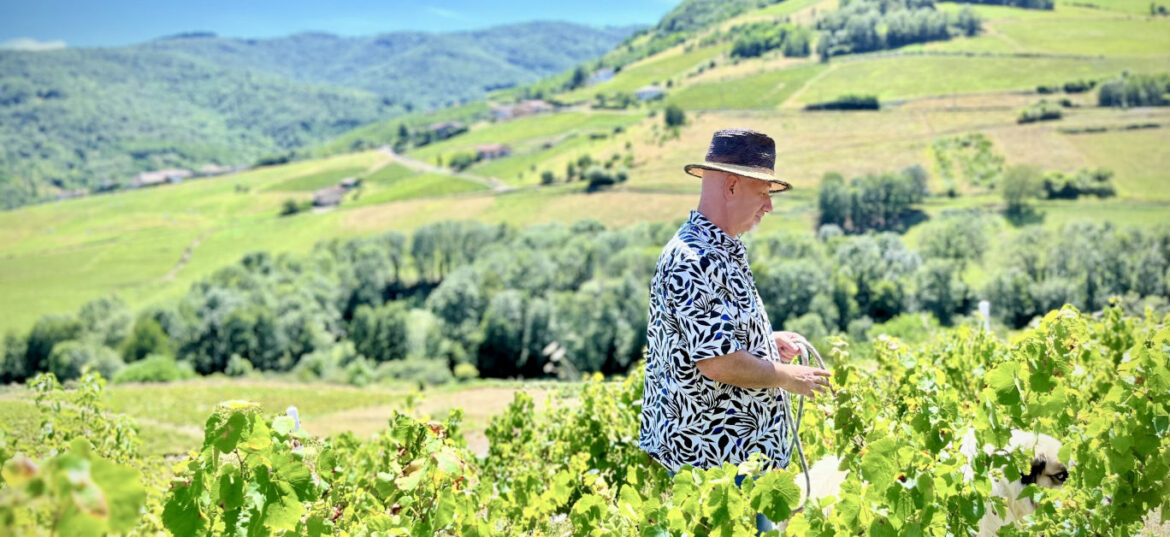Words by Helen Truszkowski
Amelie put her foot down. The vintage Land Rover Defender revved and responded. Voila ‘wine nirvana’. As we zipped past vineyards dotted with gnarled vines and olive trees, I stuck out my hand and brushed past the undergrowth. An intoxicating scent of lavender and thyme filled the car. Passing old chateaus crumbling elegantly with their peeling turquoise shutters, we arrived at the quintessential commune of Lantignié. The early morning light was honeyed and mellow, the scenery otherworldly. Orangey-gold stone limestone and iron houses dotted the horizon. Cream puff clouds dotted the sky.
I am way off-the-beaten path in Beaujolais – a French Rhône region just south of Burgundy – spending the day with Amelie, my bubbly private local guide from Insiders. I am on speed-catch-up as Amelie relates the historic rise and unexpected fall of this medieval vineyard stronghold.
For several centuries the calling cards of this region were its red wines, based on the Gamay grape which reaches its absolute peak here. But it was an unprecedented mass marketing campaign in the 1980s that suddenly skyrocketed the economics of this region with the promotion of a centuries-old tradition: Beaujolais Nouveau. Created to celebrate the end of the grape harvest through carbonic maceration, the method rests whole grapes inside a tank with carbon dioxide, triggering fermentation to flourish within the uncrushed grapes. A distinct lack of complication – some may say sophistication – brings achingly unpredictable results.
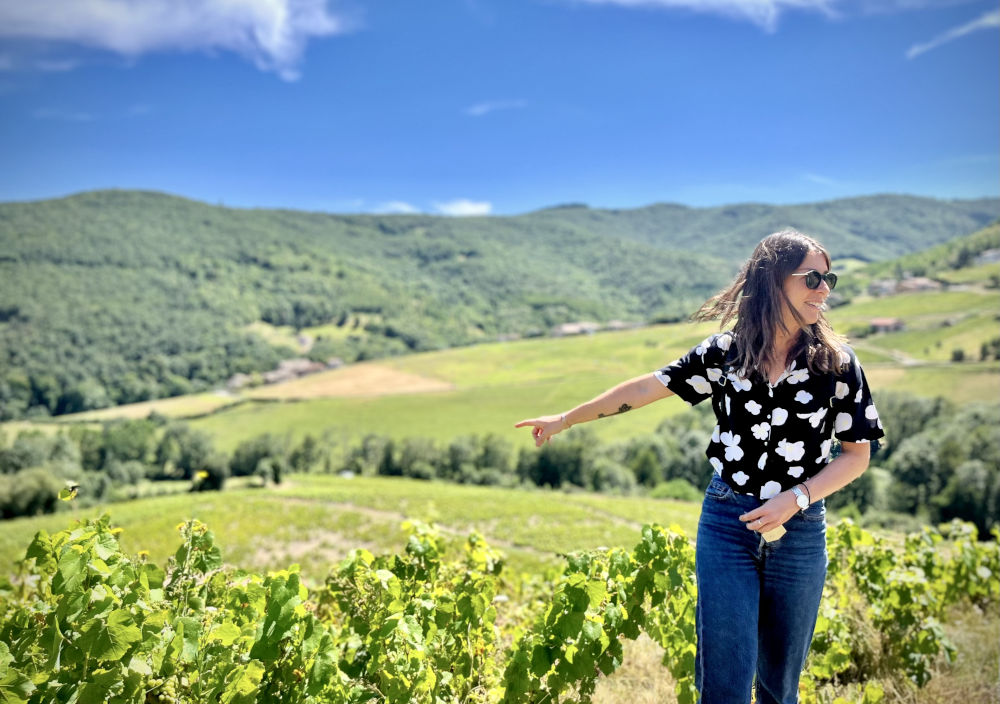 Insiders run exquisite, tailor-made immersive adventures that pair classic sightseeing with unique, insider experiences of local life and culture, led by in-the-know guides
Insiders run exquisite, tailor-made immersive adventures that pair classic sightseeing with unique, insider experiences of local life and culture, led by in-the-know guides
At its best Beaujolais Nouveau is pristine and sun-dappled. Conversely it can taste like a punkish combo of greenish grapes suffocated by sugar and sulphur. Still, in its heyday, Georges Duboeuf Beaujolais Nouveau sold as many as 1.185 million nine-litre cases in the USA. Yet it was as palates shifted towards bolder Napa Cabs, spicy Zins and buttery Chardonnays that sales suffered a devastating decline. Seen as frouffy and inconsistent, 2020’s snobbery saw its labels mocked and vineyards abandoned as public esteem for age-worthy Beaujolais red, white and rosé wines nose-dived.
Fast-forward to a new generation, with growers like Frédéric Berne and Cyril Alonso determined to halt the cultural decline. Crucially, Beaujolais-Villages wines depend on Gamay grapes grown only in the northern part of the region, and specifically in 38 permitted villages. Of that 38, Beaujolais Cru are grown in just ten specific locales whose granite soils tend to produce the most age-worthy and complex of all Beaujolais red wines.
The grandson of a farmer and son of a craftsman, raised on a farm in Beaujolais, Frédéric Berne felt an instinctive pull to the land. Attracted by wine’s power to reflect its surroundings and soil complexity, Berne spent his apprenticeship at southern Burgundy wineries, setting up his own eponymous label back in 2014. Since then he has grown to over 13 acres of certified organic vines, spread across Beaujolais-Villages, Morgon, Régnié and Chiroubles.
Breaking from intensive and chemical agriculture, Frédéric and his team curate their vines according to the precepts of agroecology. Based on a principle of sustainability that works in sync with nature, they strive to respect the ecological diversity at work here in the Beaujolais region.
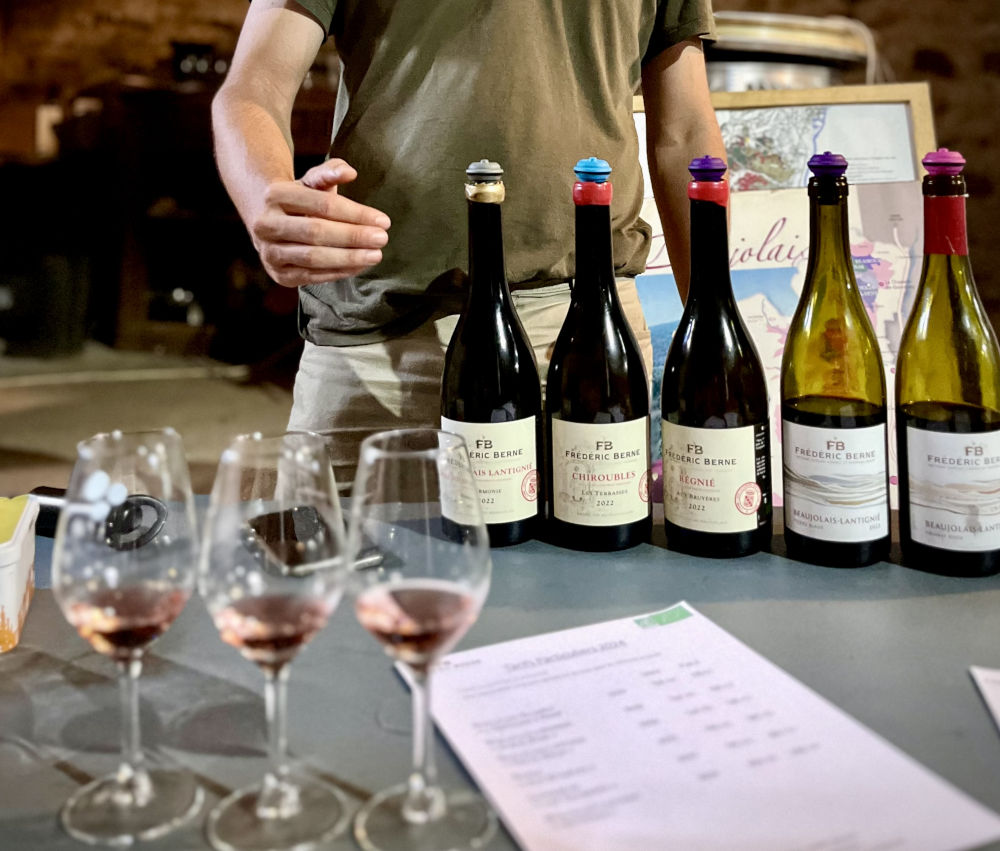 Beaujolais is almost entirely planted with the Gamay grape and produces mostly red wines
Beaujolais is almost entirely planted with the Gamay grape and produces mostly red wines
Berne’s estate sits at an elevation of almost 400 metres, cultivated on variations of granite bedrock, laced with quartz, and ‘Pierre Bleue’ soils. Each grape is harvested by hand. From here bunches are placed in stainless-steel vats to undergo semi-carbonic maceration for one day. Then the grapes are pressed in a traditional wooden, vertical press and undergo a maceration lasting five to 15 days. Frédéric follows a firm policy of minimal intervention in his winemaking, using only indigenous yeast during fermentation.
Tour of the vast vineyards, barrel room, and cellars accomplished, we got a chance to taste a few bottles in the company of team-member Antoine Dupan. With his gentle yet forthright demeanour, I started to see that Berne’s wines take on the same intensity as the hands that labour so tirelessly over them. From first sip the rich granitic soils bring electricity to these wines, as dense, concentrated cranberry, cherry and rose petal aromas proliferate. As we progressed, so the wines became more expressive and energetic.
Most notably the cuvee Lantignié ‘Granit Rose’ comprises a blend of grapes grown on pink granite soils and blue Lantignie ‘Les Bruyeres’, fermented using 80-100 per cent whole-bunch grapes in stainless steel tanks. The resulting wine is defined by an exuberant red fruit character with the granite soils lending fine tannins. The same techniques create Frédéric’s Lantignié ‘Pierre Bleue’ except the Gamay for this wine is grown on predominantly clay soils, creating a more floral, fragrant wine with notes of bramble and cherry compote.
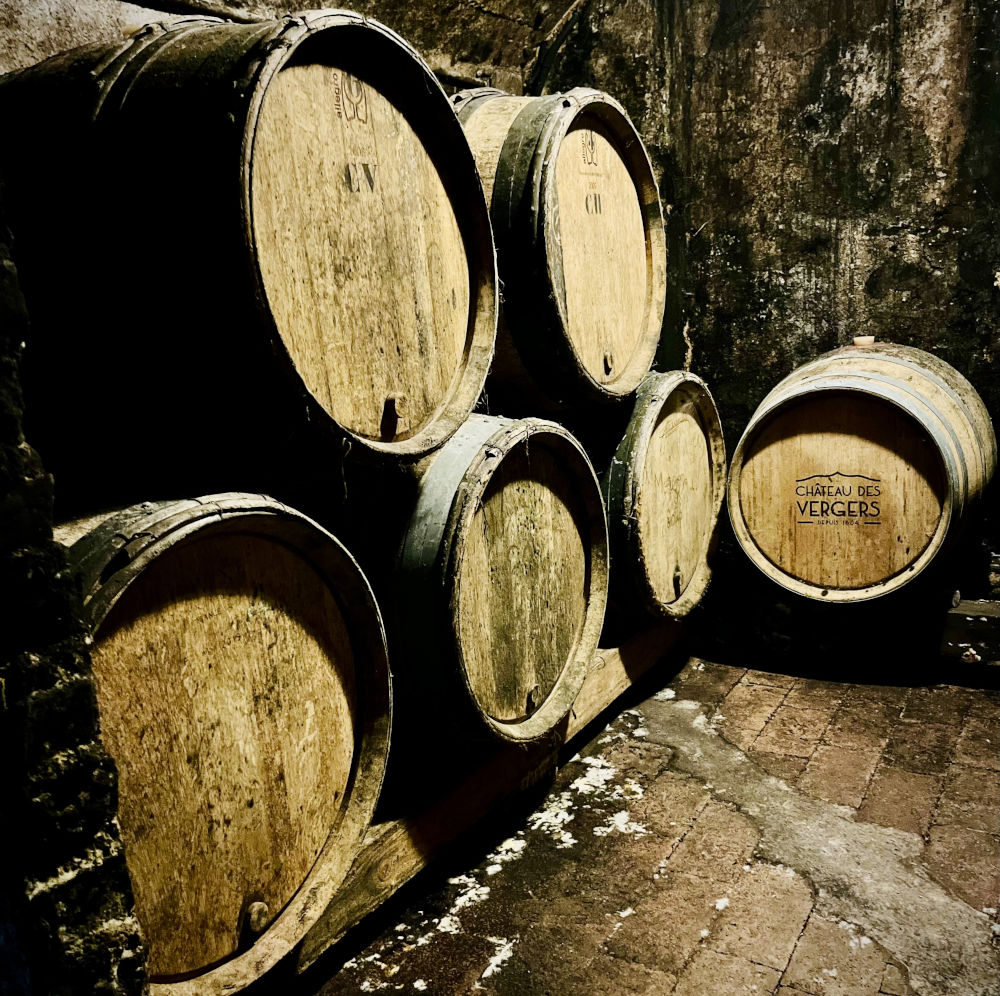 Beaujolais-Villages wines depend on Gamay grapes grown only in the northern part of the region, and specifically in 38 permitted villages
Beaujolais-Villages wines depend on Gamay grapes grown only in the northern part of the region, and specifically in 38 permitted villages
My favourite was the Régnié ‘Aux Bruyères’, sourced from a unique parcel of granite and quartz soils, aged in old oak barrels for 12 months before bottling, lending an intense purity of fruit and notable concentration to the wine.
Big on supporting fellow wine growers, the ‘au-naturel collective’ includes a tiny Domaine in neighbouring Marchampt. At the helm is Cyril Alonso. Back in 2019 Cyril and his wife Karine set out to produce a bold and experimental vineyard in the heart of a protected forest where wild bees forage while wine ferments silently in the cellar.
Amelie and I stopped by to sample a few bottles of wine and got treated to fresh local cold cuts, cheese and utterly sublime views. Composed, authentic, unassuming, we ventured out to the vineyards with no-fuss Cyril and his hulking dog in tow. Alonso’s uber-low intervention wines are made employing organic viticulture, with an emphasis on natural non-corrective, indigenous yeast vinification and low-to-zero sulphur use. Everything is done by hand here, from harvest to whimsical label.
Cyril’s vineyard vibe was distinctly self-assured and laid-back, the wines we savoured none the less so. Produced from a vast palette of Gamays, including ancient teinturier varieties, his resulting La Tribu Alonso wines are playful, earthy and mineral, densely accentuated by aromas of raspberry, peach and orange zest.
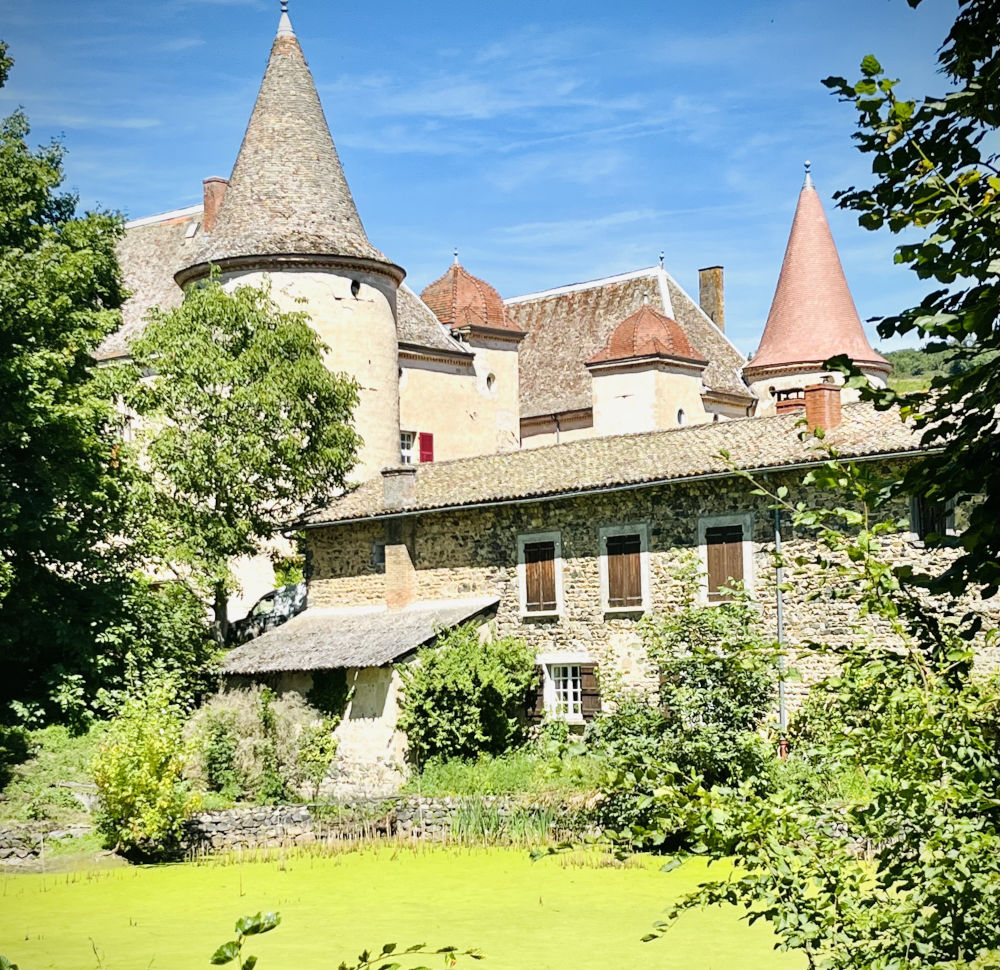 Beaujolais is a French Rhône region just south of Burgundy
Beaujolais is a French Rhône region just south of Burgundy
What is clear is that all these wines are cherished from seed to first sip. It’s that dead-simple, unabashed embrace of extraordinarily pure and traditional methods, organic viticulture and minimal intervention that is wholly reflected in Beaujolais’ modern-day wines. The proof is in the glass. For all their efforts, forward-thinking winegrowers here are redefining our vision of the region, producing wines with deeper colour, more fragrant perfumes and softer tannins that lend an elegance and purity to a bevy of nouveau Beaujolais.
Factbox
Frédéric Berne – Domaine Viticole – Address: 150 Chem. des Vergers, 69430 Lantignié, France.
Karine et Cyril Alonso – La Tribu Alonso – Address: 210, impasse de la Rivière, 69340 Marchampt, France.
Insiders run exquisite, tailor-made immersive adventures that pair classic sightseeing with unique, insider experiences of local life and culture, led by in-the-know guides.
My off-the-beaten path tour by vintage Land Rover starts at 400 euros for a half-day tour for one to three people.

